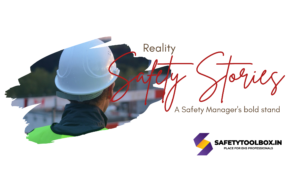At Velocity Industries, a leading name in the automotive sector, safety had always been part of the company’s values. But behind the polished policies, the reality was much different. Vikram Mehta, the safety manager, felt the strain every day. His team was constantly on call, managing a 24-hour operation without enough resources. The expectation from the higher-ups was clear: the safety team should be available round the clock, ready to handle emergencies. But there was little support beyond that demand.
Despite the company’s growing success, safety incidents—though minor—were becoming a frequent problem. Some injuries went unreported, and near-misses were ignored. The burden on Vikram’s small team was growing unbearable. He knew that without immediate changes, it was only a matter of time before something serious happened.
And then it did.
One night, just past midnight, a conveyor belt in the production line malfunctioned and caught fire. Thanks to Vikram’s quick-acting team, the fire was controlled before it spread, but the situation could have been much worse. The next morning, during a tense meeting, the senior managers were far from sympathetic. “Why wasn’t this prevented?” they demanded, hinting that the blame lay squarely with the safety team.
Vikram knew it wasn’t fair, but more importantly, he knew this was a turning point.
For days, he gathered data and prepared for a difficult conversation with the company’s top executives. When the time came, Vikram didn’t hold back. “Safety is not just a checkbox for my team to tick off,” he began. “It has to be a company-wide commitment, and that starts from the top.”
He backed his safety statement with hard facts:
According to the National Safety Council, businesses with active leadership engagement in safety efforts experience 52% fewer workplace accidents.
A global survey of high-risk industries found that companies with proactive safety cultures saw a 35% drop in incidents and a 50% boost in employee morale.
The International Labour Organization (ILO) reports that workplace injuries and deaths cost companies over $1.25 trillion annually—losses that could be significantly reduced with better safety management from leadership.

Vikram’s message was clear: the safety team couldn’t carry this load alone. He proposed several critical steps:
1. Leadership-Driven Safety Audits: Senior management should lead regular safety reviews, not just rely on the safety department.
2. Investment in Technology: Real-time monitoring systems should be implemented to detect and prevent malfunctions before they become dangerous.
3. Mandatory Safety Training: Every employee, including executives, would undergo training to understand the importance of safety leadership.
4. 24/7 Safety Support: The company must hire more safety staff and ensure mental health support for workers to prevent burnout.
“Expecting us to be available 24/7 without the right resources isn’t sustainable,” Vikram continued. “If we want real change, safety has to be owned by everyone, starting with the management.”
His words struck a chord. The leadership agreed to Vikram’s proposals, approving a 35% increase in the safety budget and committing to a culture shift. Over the following months, new safety technologies were introduced, more staff were hired, and management actively participated in safety inspections.
Within a year, the results were remarkable. Velocity Industries saw its accident rate drop by 47%, while productivity rose by 15%. The company was even recognized as one of the Top 10 Safest Workplaces in its industry. Not only did the business save millions in reduced downtime and medical costs, but employee morale soared as well.
Vikram’s stand became a pivotal moment for Velocity Industries, showing that safety isn’t just the responsibility of one team. When leadership takes ownership, the whole company benefits. At Velocity, safety was no longer an afterthought—it became a way of life, and it all started with one safety manager’s courageous decision to speak up.
I hope this story has been helpful. Please support us to receiving more interesting stuff.
For regular updates on safety topics or videos follow us on LinkedIn
for more safety toolbox talk click here…

This story highlights the crucial role of leadership in fostering a safety culture. By prioritizing comprehensive safety training and resources, companies can significantly reduce incidents and enhance employee morale. Ownership is key!
Almost these situation in majority industries of safety head
100%. True!!!! Safety ownership from the top down is crucial!
I recommend it as an HSSE professional. Everyone should pursue excellence in all aspects and everything, regardless of safety professionals. Aim to prevent accidents, protect the environment, and minimize disasters for your and your family’s safety and the well-being of the company’s reputation.
agree with this story. No matter how many standards, procedures, or safety campaigns (everything is important of course) without managers involved on employeeˋs safety, injuries will be expected to happen.
Management by Walking around, will allows to recongnize in real time good practices and to identify shortcuts/unsafe acts, with a inmediate feedback, and continue performing the activity in a safer way. Employees will appreciate
that and, eventually, this will reduce the possibility of an incident.
Everyone in the company, is an HSE leader. Thatˋs the mindset.
El liderazgo de las compañías deben ver y sentir la seguridad como un valor y no como una prioridad. En una lista de prioridades eliges según tu conveniencia, los valores no se transan.
This story highlights several critical aspects of workplace safety and leadership:
1. Leadership Commitment: Vikram’s experience underscores the importance of leadership in fostering a safety culture. When senior management actively engages in safety efforts, it sets a tone that safety is a priority for everyone.
2. Resource Allocation: The strain on Vikram’s team due to insufficient resources is a common issue in many organizations. Adequate staffing and investment in safety technologies are essential to prevent incidents and manage emergencies effectively.
3. Proactive Measures: Implementing real-time monitoring systems and conducting regular safety audits can help identify potential hazards before they escalate into serious incidents.
4. Training and Awareness: Mandatory safety training for all employees, including executives, ensures that everyone understands their role in maintaining a safe workplace. This can lead to a significant reduction in accidents and an increase in employee morale.
5. Mental Health Support: Addressing the mental health of safety staff and other employees is crucial. Burnout can lead to mistakes and oversights, which can compromise safety.
6. Data-Driven Advocacy: Vikram’s use of data to support his arguments was pivotal in convincing the leadership to take action. Presenting hard facts and statistics can be a powerful tool in advocating for necessary changes.
Overall, this story is a powerful reminder that safety is a collective responsibility that requires commitment and action from all levels of an organization. When leadership takes ownership of safety, it can lead to significant improvements in both safety outcomes and overall organizational performance.